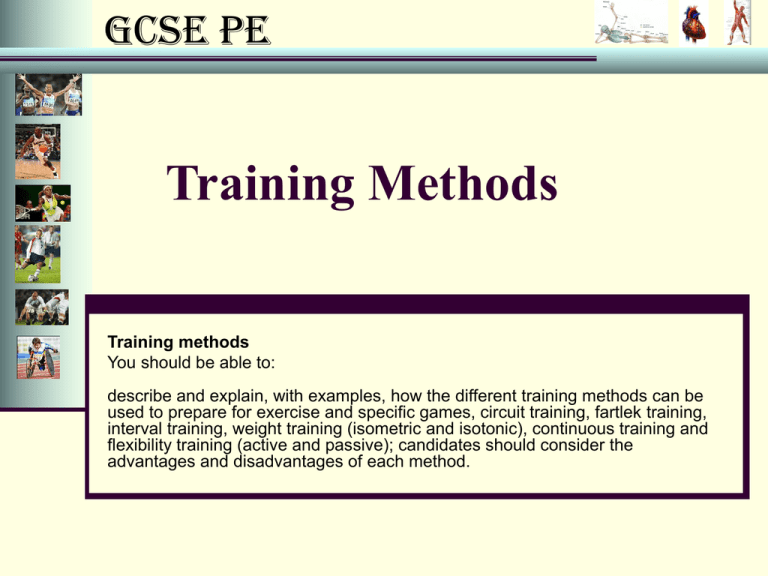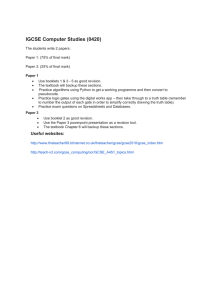GCSE PE Training Methods: Interval, Circuit, Fartlek & More
advertisement

GCSE PE Training Methods Training methods You should be able to: describe and explain, with examples, how the different training methods can be used to prepare for exercise and specific games, circuit training, fartlek training, interval training, weight training (isometric and isotonic), continuous training and flexibility training (active and passive); candidates should consider the advantages and disadvantages of each method. Training Methods There are 6 principle methods of training: 1. INTERVAL Training 2. CONTINUOUS Training 3. FARTLEK Training 4. CIRCUIT Training 5. WEIGHT Training 6. FLEXIBILITY Training GCSE PE Why are we doing this? Which training methods are relevant to you and your weaknesses? Explain why it is beneficial to look at case studies and create programmes for others. How will you use this to write your training programme (coursework – 10%)? GCSE PE INTERVAL Training This involves periods of work followed by periods of rest. The work interval may be a distance to run, say 60m, or a time to run, say 10 secs. The rest interval may be a walk back to the starting mark, or simply not working (rest). There are many advantages to this type of training: GCSE PE INTERVAL Training 1. It includes repeated sprint running or swimming, which is ANAEROBIC. 2. It takes place over short periods or bursts 3. It includes a rest period which allows for recovery 4. It includes repetitions of high quality, which raises the pulse into the TRAINING ZONE. INTERVAL TRAINING is particularly suitable for team game players, as it consists of short bursts followed by slow walking or stopping. GCSE PE GCSE PE CONTINUOUS Training It could start with brisk walking and graduate to jogging. It could be over a distance or over time. In continuous training, the athlete does not stop working. The advantages of continuous training are: GCSE PE CONTINUOUS Training 1. You can work on your own or in a group 2. It is suitable for health and fitness 3. It improves AEROBIC fitness. 4. It can take place in a variety of places. 5. It can be adapted to suite INDIVIDUAL NEEDS. GCSE PE CONTINUOUS Training GCSE PE FARTLEK Training The word Fartlek is Swedish and means SPEED PLAY. It is another form of continuous training, but combines fast and slow running. In many ways it is like Interval Training. You have sprints and jogs and other periods of work followed by short periods of rest. The advantages of Fartlek training are: GCSE PE FARTLEK Training 1. It can be done in a variety of terrain e.g. sand dunes, parkland, forest, fields, etc. 2. It can include hill work 3. It can include repetitions 4. Programmes are very flexible 5. Rest periods can be included or the session can be continuous with intermittent hard and easy running. GCSE PE Heart rate of cyclists on an all-terrain Fartlek (Speed Play) ride GCSE PE GCSE PE CIRCUIT Training Involves a number of exercises set out so you avoid exercising the same muscle group consecutively. Each exercise takes place at what is called a station. The exercises may be carried out for a length of time e.g. 30secs, or a set number of times. It is the most flexible form of training and circuits can be devised to develop any of the components of fitness. GCSE PE CIRCUIT Training After completing each set of repetitions, the athlete moves on to the next exercise. Another way to use a circuit is to have a skills circuit for a particular sport. In this case, instead of doing different exercises at each station, a different skill from a sport can be practised. For example, a Basketball skills circuit could have dribbling at station 1, chest pass at station 2, shooting at station 3, etc. The advantages of CIRCUIT TRAINING are: GCSE PE CIRCUIT Training 1. It offers a much more general all round fitness than the other 3 methods. 2. It includes strength, endurance, power, flexibility and speed. 3. People of all levels of fitness and ability can take part. 4. It includes both AEROBIC and ANAEROBIC activities. 5. It uses a wide range of activities 6. People work hard and can be highly motivated to GCSE PE succeed. GCSE PE WEIGHT Training WEIGHT TRAINING is a form of training that is most commonly used to improve strength and muscular endurance. It requires a resistance, usually in the form of a dumb bell, barbells or modern weight training (resistance) machines. Weight training makes use of the progression principle of training by gradually increasing the amount of weight handled. WHAT IS WEIGHT TRAINING USED FOR ? GCSE PE WEIGHT Training 1. Increase muscular strength 2. Increase muscular endurance 3. Increase speed 4. Develop muscle bulk 5. Rehabilitate after illness. HOW DO I CONSTRUCT A WEIGHT TRAINING SCHEDULE ? GCSE PE WEIGHT Training Included in a training schedule are: 1. The number of exercises 2. The exercises for each muscle group 3. The weight used 4. The number of repetitions 5. The number of sets 6. How fast the exercise is done 7. How long the rest is between sets 8. The frequency of training. GCSE PE GCSE PE FLEXIBILITY Training The aim is to increase the range of movement allowed at a joint, or series of joints. Flexibility training improves performance in the majority of sports and helps the performer to avoid injuries. Flexibility is improved by STRETCHING the muscles and tendons to a point marginally beyond their normal limits. There are 2 main ways to develop flexibility: GCSE PE FLEXIBILITY Training ACTIVE STRETCHING When the performer can stretch joints easily, on their own, without undue difficulty. PASSIVE STRETCHING When the full range of movement can only be achieved with assistance from a partner or coach. The performer relaxes and allows their partner or coach to perform the stretching movement. GCSE PE REVISION GCSE PE GCSE PE GCSE PE GCSE PE GCSE PE GCSE PE GCSE PE GCSE PE






